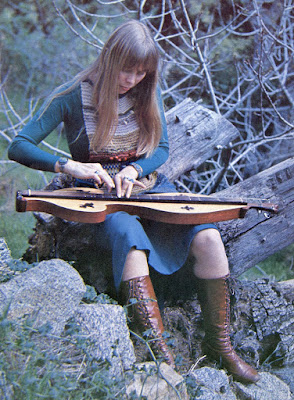By the Throbbing Light Machine
I've been drinking deep from a new Joni Mitchell collection, five hours of music under the title Archives—Vol. 1: The Early Years (1963-1967), much of it live appearances at coffeehouses and small venues as she found her voice, literally and figuratively, as a self-accompanying artist in the years before she made her first records. Though this probably would not be an ideal introduction for the uninitiated, for a Mitchellhead like myself, it is something of a revelation to hear young Joan Anderson's prim, pretty, austere versions of folk standards of the day, from "House of the Rising Sun" to "Molly Malone," from "Dink's Song" to "Pastures of Plenty," as they give way in just a few years to impressive early originals like "Urge for Going" and "Eastern Rain," the latter of which sounds to me like a template for much of her art-song-worthy later output, with some stormy, broody flourishes and vertiginous chord changes.
I was especially thrilled to hear the roots of her questing compositional genius taking shape even in the early folk arrangements. Most strikingly, on the pseudo-Trinidadian pastiche "Oh Sail Away," she takes the second chord of the verse very far afield from the original. Penned by John Phillips (later of the Mama & Papas) and Richard Weissman, the song is famous from the Kingston Trio rendition, in which the second chord of the verse is admittedly a bit odd; the song is in A, and the second chord sounds a bit like a B-flat sixth (maybe with a flat 5?). It's first heard at :37 below:
Most bands seem to play that second chord as a very non-strange-sounding G, though.
Joni has other ideas. She moves the key up to B, so that second chord should be a C (or perhaps an A or A-minor). But listen instead to what she does instead, right out of the gate:
That's a B to an F major, a very exotic progression, a full tritone; and just listen to the otherworldly chromaticism it gives her vocal melody at :18. I think it's quite possible she stumbled on this strange sound while strumming her dulcimer—an instrument that lends itself to bright, unsubtle triads, at least in the hands of a beginning player—as she was trying to approximate that weird, suspended-sounding Kingston Trio chord. What makes Joni a great artist, even at this early stage, is her full commitment to what might sound to others like a mistake, which she instead turns into something oddly beautiful and all her own.
Indeed, anyone steeped in her unique harmonic world will recognize the odd jolt of that sound from "Songs to Aging Children Come" (the precipitous drop from an F to B chord at :15 below):
It also turns out to be the leap she makes in possibly my second favorite of her songs (after "Banquet"). In the bridge of "My Old Man," she slouches from the home key of D* into a bluesy A-flat minor, another jarring tritone leap, but this time employed less as a showy compositional gimmick than as a deft emotional trigger, a crack of vulnerability in the song's proud front. By this time, fully developed as a composer, Mitchell is using her musical palette to paint masterpieces. The Archives give us the lucky chance to hear the original colors get smeared, with bracing confidence, onto that palette.
A final note: The Archives also contains an early version of her heartrending tribute to the daughter she gave up for adoption, "Little Green," in which she opts for another off-kilter chord at a key juncture, later changed to a far less jarring and more effective harmony for the album Blue.
*Oops, it turns out I'm wrong about this—the home key of "My Old Man" is A, though it spends a lot of time on the D. So the interval into the bridge is just a half step down. Still a pretty adventurous harmonic choice.





Comments
Post a Comment